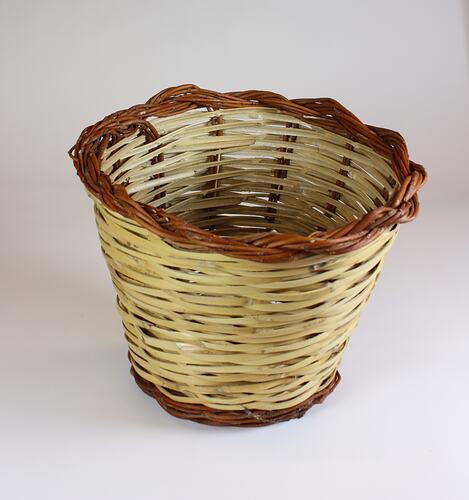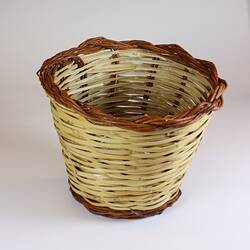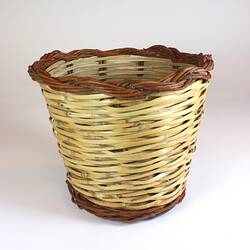Summary
Traditional Sicilian basket hand made by Salvatore Mazzarino from two types of woven cane. The basket is made for storing olives and salt and the cane he grew, harvested and prepared from his own garden in St Albans.
Salvatore Mazzarino migrated to Melbourne from Vizzini, a rural town in Sicily, Italy in 1961. From a farming family he had served in the Italian army during World War II. He married Gesualda Ragusa in 1947 and they migrated with their two children [a third would be later born in Melbourne] on the Flotto Lauro line 'TN Roma' in 1961. They finally settled in St Albans, purchasing the neighbouring block to provide for a generous market garden. Salvatore worked as a blacksmith at the Newport rail yards until he retired around 1984, but his passion was his garden and he utilised his farm cultivation skills to growing a diverse array of fruit, vegetable, herbs and flowers. The produce was primarily for family consumption but Salvatore gave much away to family, friends and neighbours. In order to collect and store the produce, Salvatore made baskets from cane that he grew himself in his garden. The baskets are woven in a Sicilian style and he probably learned the skill from his father.
Physical Description
Medium sized woven basket without handle, with a slightly dropped front. The body of the basket is woven from single pieces of split light yellow cane. The base of the basket is constructed from a radial pattern of single strand red cane. The border of the basket is woven from a twisted plait of multiple red canes.
Significance
This rich collection of hand-woven baskets, tools and photographs tells stories of migration, settlement on the outskirts of Melbourne, trade and industry, market gardening and traditional cultural practices through the baskets. This collection is particularly evocative because photographs document Salvatore Mazzarino at work in his market garden and with one of his hand-made baskets in use. It also enables the representation of disappearing male traditional cultural practices in the collection which is currently dominated by examples of women's creative cultural activities.
More Information
-
Collecting Areas
-
Acquisition Information
Donation from Marianna Rando, 10 Oct 2012
-
Maker
Mr Salvatore Mazzarino, St Albans, Greater Melbourne, Victoria, Australia, circa 1990s
-
Classification
Cultural identity, Ethnicity - cultural practices, Food & drink production
-
Category
-
Discipline
-
Type of item
-
Overall Dimensions
320 mm (Width), 320 mm (Depth), 290 mm (Height)
Height of dropped front: 235 mm.
-
Keywords
Migration & Settlement, Baskets, Weaving, Gardens, Vegetable Gardens, Vegetables, Harvesting Equipment, Handcrafts, Olives, Salt




